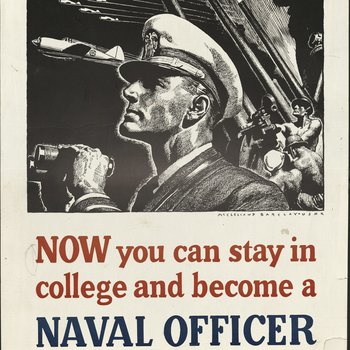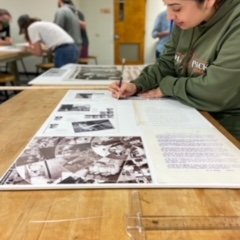East Texas State Teachers College in World War II
In Fall 2021 Texas A&M University-Commerce Department of History mounted a student-produced exhibit at the Audie Murphy/American Cotton Museum in Greenville, TX. East Texas State Teachers College in World War II (ETSTC in WWII) ran from November 15, 2021, through January 14, 2022.
The physical exhibit was a collaborative effort of graduate and undergraduate Public History students who researched items in the Velma K. Waters Library Special Collections and University Archives. The exhibit featured five displays covering campus involvement in U.S. military training at ETSTC, educational changes on campus during and post-war, the involvement of the faculty, students, and staff in the national efforts of war bonds and rationing, as well as a section on letters to/from home. Exhibit highlights include:
- Letters sent from John Garland Smith and Jewel Kennemer to Gretchen Howell, an ETSTC librarian during WWII
- Images from The Locust, the ETSTC yearbook (1941-1943)
- Letters from President Whitley to the faculty
- Reproductions of posters from the U.S. Office of War Information
This new digital exhibit allows for everyone to see how ETSTC responded to key themes in the national war effort. This exhibit conveys how the local community took part in national narratives and how this connected Hunt County residents and ETSTC students, faculty, and staff to the larger American drive for a successful outcome of the war.
The exhibit is divided into five categories where there was overlap in the primary source documents in the Gretchen Howell Collection, the University History Vertical File, the Board of Regents Minutes, and the Office of War Information posters. The categories of War Bonds, Rationing, Military Training at ETSTC, Letters Home and Morale, and Education enable the use of ETSTC primary source documents – the letters, memoranda, photographs, meeting minutes, etc. – in conjunction with the posters from the Office of War Information. This exhibit uses posters to tie the local document to the national efforts. The posters are the representation of what the government/federal/national message was and the university documents and photographs illustrate how ETSTC responded and fit into these messages tying the local history to the national history of World War II.
The final section of this exhibit showcases the students and the process of mounting a physical exhibit at The Audie Murphy/American Cotton Museum. Including the physical preparation of exhibit items, presenting at a conference, and an Opening Reception at the museum.






